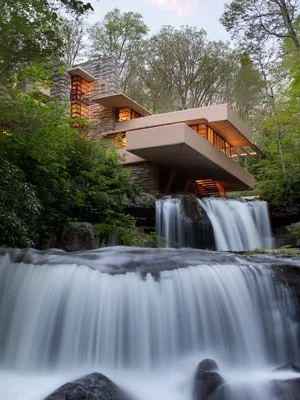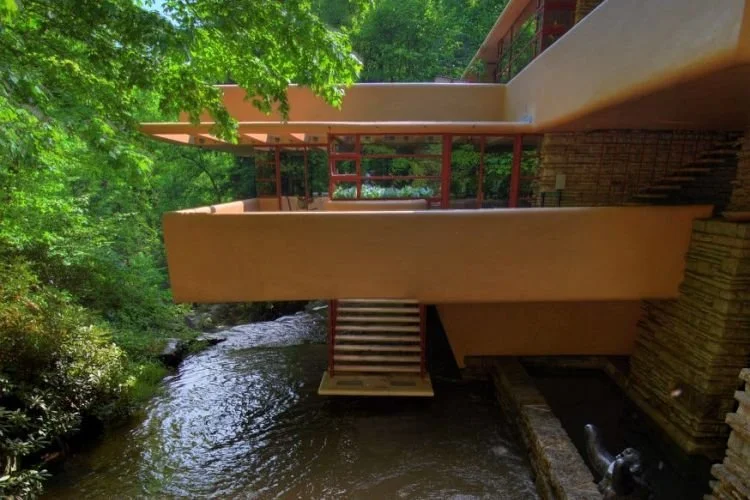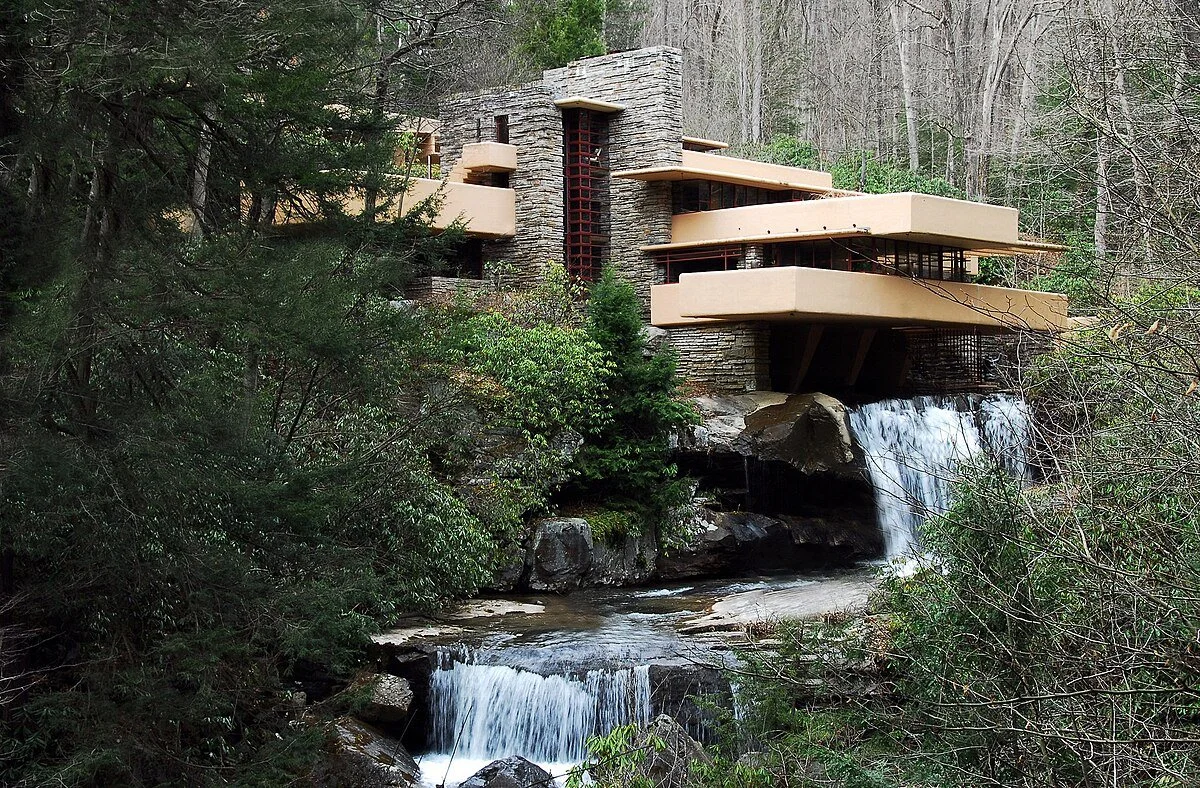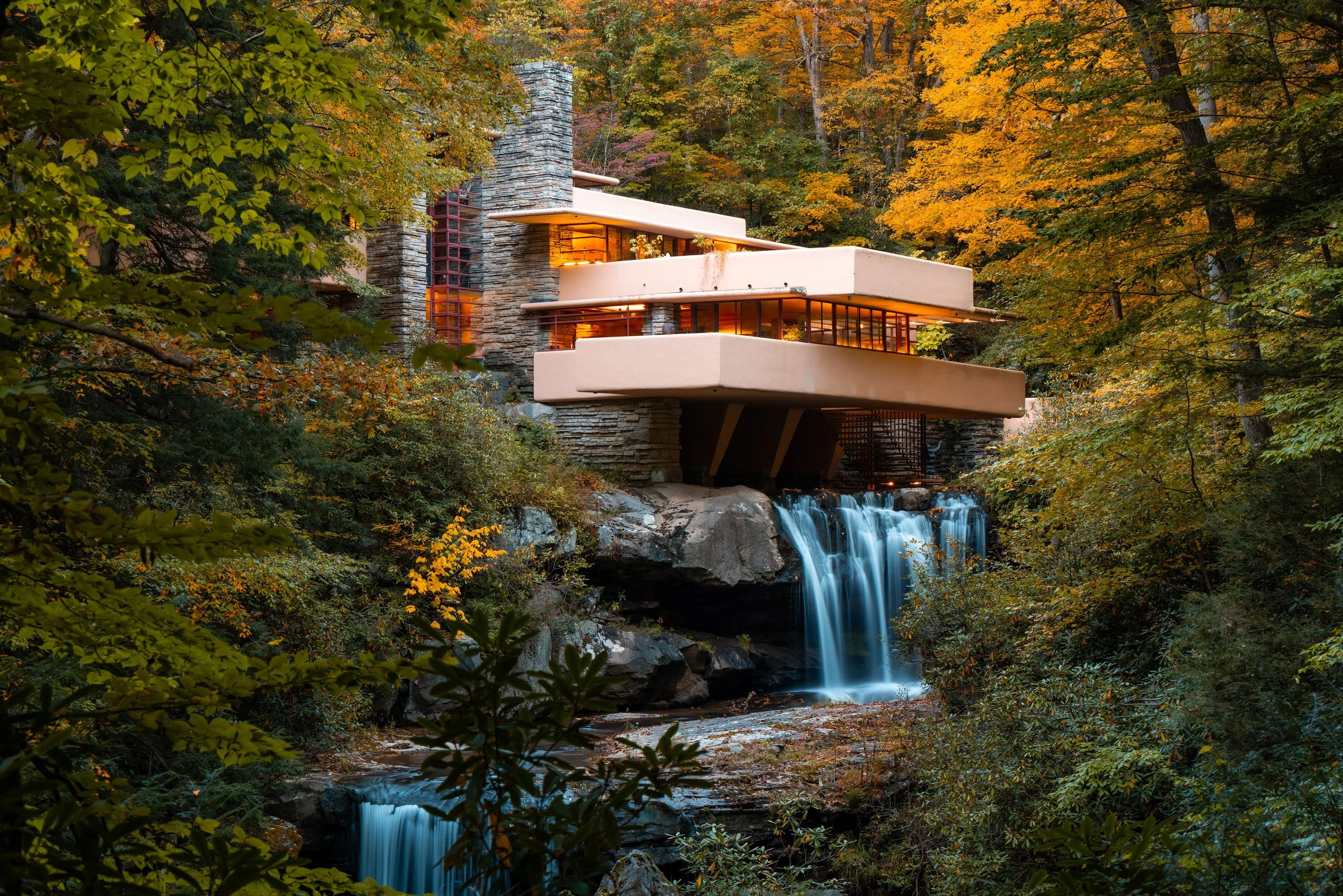A “Falling Water” Story
Frank Lloyd Wright’s Organic Architecture:
One of my favorite stories from Architecture centers around one of the most famous Architectural works in American History and it's even more famous designer, Frank Lloyd Wright's Falling Water. This well-known project’s origin story is a fun tell, allowing us a glimpse into the talent and ego of how one of History's greatest design minds interacted with his elite wealthy clientele.
There are numerous lessons to be learned from the different facets of this tale alone, including the timeline story of how the entire concept design was fleshed out in 2 hours in advance of a surprise client visit to check on progress. However for today, I am focusing on a lesser-known aspect of this infamous client meeting -- where Wright surprises his client with the unexpected placement of the home itself.
Falling Water: The Frank Lloyd Wright Masterpiece that Defined Organic Architecture.
First, the backstory. In 1934, Wright was working to resurrect his career from a decline wrought by the Great Depression, personal tragedy, and his infamous ego. Facing financial bankruptcy, he established his 'Taliesin Fellowship' where he ingeniously had bright, young, aspiring Architects actually pay him for the privilege of working under a master to learn both Architecture and his tenets of living. (This is yet another story to tell on another day).
The fellowship, housed at his famed home Taliesin in rural Wisconsin, attracted students from around the world, including one student, Edgar Kaufmann Jr, the only child of Edgar and Liliane Kaufmann, owners of a Pittsburg PA Department Store.
Kaufmann was 25 when he introduced Wright to his parents, and a commission to design a weekend house on a rural woodland property they owned in the Mountains of Southern Pennsylvania soon followed. Edgar Kaufmann Sr. was a powerful and dynamic entrepreneur who had transformed his family's business into one of the nation's leading Department Stores -- Kaufmann's -- flourishing where others failed through the challenges of the Great Depression. It was a perfect union: A great Architect in need of re-establishing his reputation paired with a visionary client with deep pockets and an extraordinary site.
Wright made a site visit to the property in the fall of 1934, where he spent several days traveling to and exploring the site, hiking the terrain and exploring the natural beauty and cascading waterfalls of Bear Run Creek that ran through the center of the property. There was one spot in particular that caught Wright's attention as he pondered. It was a natural clearing at the center of the property with a perfect view of Bear Run's signature waterfall. This was also the spot where the Kaufman's spent most of their time when they visited the property on their getaways from the city.
When Wright returned to Wisconsin, he gathered all of the property information, including the topographic map of the property and his site notes -- then the project sat untouched for almost a year. In correspondence with Kaufmann over this time, Wright assured his wealthy and demanding client that much work was being done on the project and that the design was proceeding nicely. In actuality, he hadn't sketched the first line. After 10+ months, Kaufmann was growing impatient and scheduled a surprise visit to Taliesin to view the progress on the design himself. On the morning of September 22, 1935, Kaufmann landed in Milwaukee, then phoned Wright to tell him that he was on his way to Wisconsin, and would be at Wright's home in two hours to review the design he had been working on for a year.
Faced with a similar client phone call, this would send terror down the spine of every designer. But with the confidence and ego that defined Frank Lloyd Wright's persona, he put down the phone with a smile, walked confidently over to a drafting table and, surrounded by his Taliesin apprentices, he began to sketch. Over the next hour and a half, Wright sketched his concept for the home, drawing a series of floorplans, a perspective rendering, and a series of elevations showing how the structure blended seamlessly with the topography and natural features of the site.
Kaufmann and his entourage arrived right as Wright finished the last detail on the elevations. He answered the door with the now famous phrase, "Ah… We've been waiting for you, EJ." This is lesson that I will discuss in another post -- about the design process and timelines, but that is not the story for today.
When Kauffman arrived, he was hot and ready for a confrontation with Wright as he (correctly) assumed that Wright had not prepared much of anything on his project -- he certainly hadn't seen the first sketch in 10 months, and for a successful businessman who was accustomed to getting his way -- and fast! -- this was not acceptable… and Wright was about to learn that.
When they sat down and Wright first unveiled his plans, Kaufmann immediately noticed one key thing and sharply criticized what was to him an important point. "Why isn't the house here!" Kaufmann tapped his finger at the clearing where they had discussed siting the house -- the location with the perfect view of the waterfall. "It is supposed to be here!" He exclaimed.
"EJ. I want you to live WITH the waterfall. Not looking AT the waterfall."
Wright continued. "I want you to hear the calming sounds of the rushing falls from the Kitchen or the Living Room. This impact could not be experienced living downstream and looking up at the waterfall. If the house were downstream, the waterfall would be like a painting."
And this is what makes Falling Water one of America's greatest Architectural Achievements. A painting or a scenic view is beautiful for sure. Often awe-inspiring and will take your breath away when you see it for the first time. But the next day when you see the same view, a small part of the luster is missing. And then the next day, and the next, and the next after that. After a relatively short period of time, faced with the same view that does not change over and over again, the mind already knows what it will see, and eventually quits even looking up at the picture, scene, or view.



I experienced this same occurrence just this month on our family vacation to Melbourne Beach, Florida. We rent a beach house right on the beach, about 100 yards from the water's edge every few years there. I woke up the first morning, grabbed my coffee, phone, and computer, and went to the balcony to watch the sun rise. I couldn't make myself look down at my work as I was mesmerized by the natural beauty of God's handiwork in front of me. I took picture after picture as the colors changed from soft to strong and as the sun began to emerge from the horizon and join the clouds, casting golden rays to the sparkling ocean water below. It filled my soul that day. And then again the next. But after a few more days of watching that same sunrise, the magic was reduced by a degree each time. And by the end of our 10-day trip, I would always still give the sunrise a glance, but became quickly distracted or pre-occupied with the work that I had on the screen in front of me.
A picture is just that -- a visual representation of beauty, but it does not have a lasting effect. Our other senses, however, provide true and experiential 'lasting power' that keeps us engaged and holds a power over us that is exceedingly difficult to shake or to walk away from.
This same beach view that became mundane after a series of 30-minute views over the period of a week had a completely different engagement effect when we went down to the water's edge.
We would spend hours upon hours every day with butts planted in beach chairs as we listened to the sound of the waves crashing before us. We felt the warmth of the sun on our skin and the cool waters on our legs as the waves ran up the beach and stopped right where we had perched our chairs. We could smell the salty air and feel the constant 'beach breeze' wash over us while washing away the stresses of our daily lives.
It was a complete sensory renewal that revitalized and reinvigorated our spirits, using that week break to restore something that had eroded in our lives over time and prepare us to take the second-half of the year on with energy and excitement -- prepared to tackle the tasks ahead.
Back to our story, Kauffman listened to what Wright was saying about the experience of the water instead of the view of the water, and his entire countenance changed. A lightbulb went on in his head as he reflected on his experiences swimming and relaxing waterside in that very stream. THIS is what LIVING is about. With this design, the Bear Run Waterfall was not a view from the house, it was PART OF the house. Kaufmann was sold on the idea. He told Wright, "I want the house build EXACTLY as it appears on these drawings!" He said emphatically. Kaufmann walked away with a smile on his face and the belief that he would soon be in possession of a truly iconic home -- one that would change the way they lived their lives every day.
This was the origins of Frank Lloyd Wright's vision of Organic Architecture that sought to create harmony between human habitation and the natural world. His concept emphasized the idea that buildings should be integrated into the environment, both in appearance and function, rather than imposed upon it.
“No house should ever be built on a hill, or on anything. It should be of the hill. Belonging to it. Hill and house should belong together, each the happier for the other. ”
I am developing a short course (hopefully coming soon) that goes deeper into Frank Lloyd Wright's Organic Architecture vision. In it we will examine the 6 core principles of Organic Architecture and how this focus can transform spaces of all types (commercial, institutional, residential, etc.) to bring a sense of peace, calm, oneness and unity into our lives that is so often missed when we, as designers, do not stop and examine WHY things make us feel the way we feel.
As a parting example, I am following and excited about a new type of luxury experience resort currently being developed -- not far from my home and office in the foothills of the Eastern Tennessee Mountains. Slated for the initial villas to open in the Summer of 2026, the vision for this unique resort villa escape is to present a return to nature experience framed by luxury with seamless living accommodations nestled in extraordinary natural settings. Below are several of the promotional social media images for 'Riviere Resort' in Eastern Tennessee.
This example is the epitome Frank Lloyd Wright's vision of Organic Architecture, a modern-day version of Falling Water in a like setting -- but a series of rentable luxury villas to be experienced by resort guests. My hopes is that the execution of this design lives up to the vision. I will be on the early list to experience and let everybody know when it launches next Summer!
As always, thanks for taking the time to read and ponder some of my deeper thoughts on design and this Watershape + Outdoor Living industry. I am humbled and always appreciative of the time you spend listening to the thoughts in my head, and your comments and opinions in the comments below or on Social Media.
Until next time — Jason






















